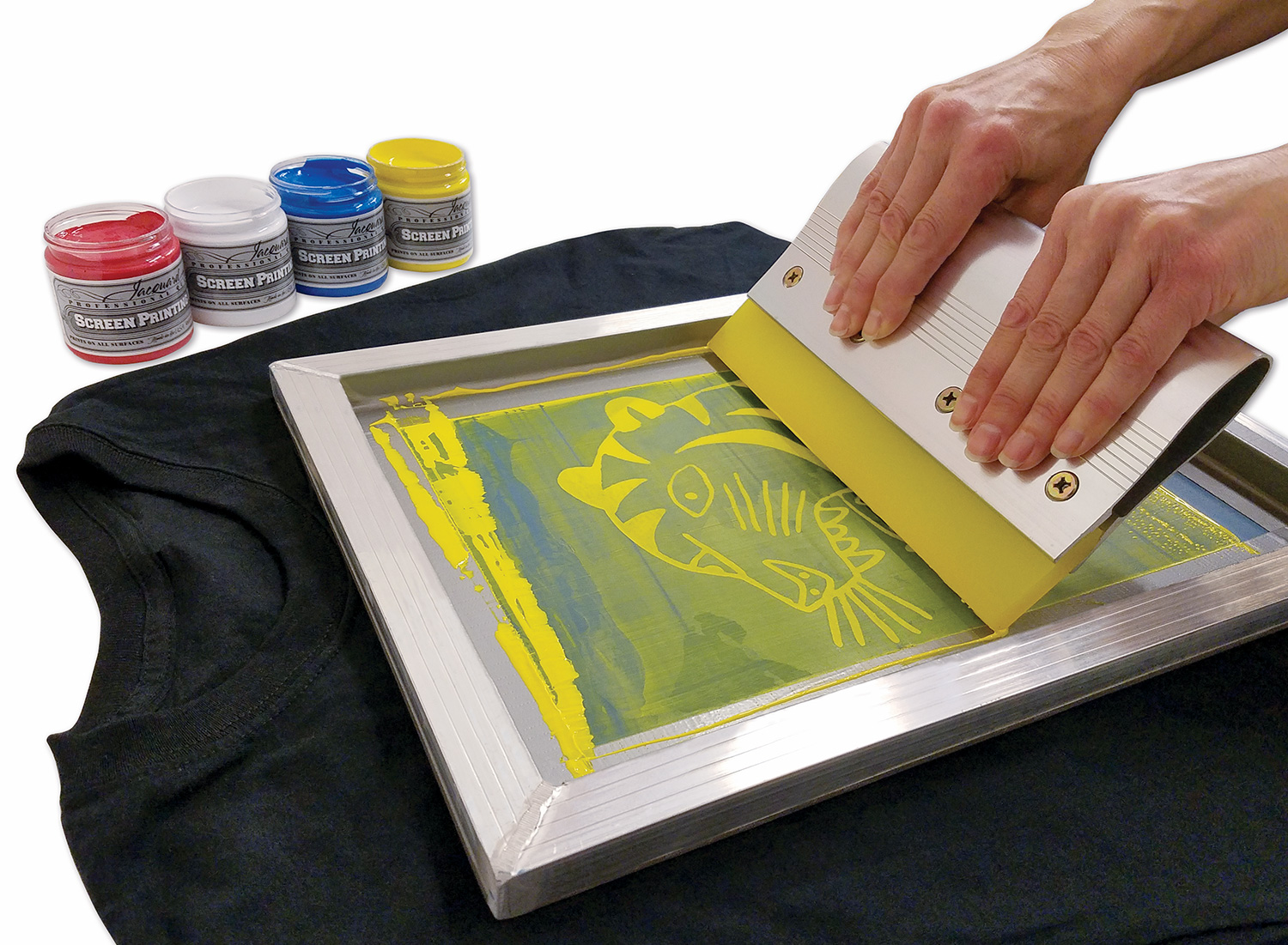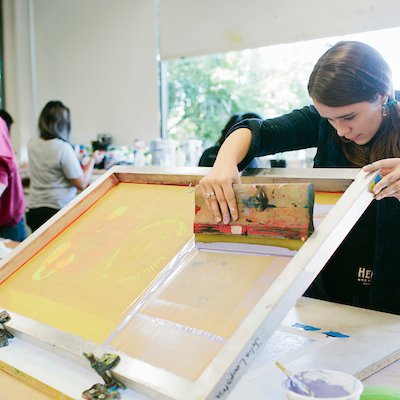ChatGPT said: How 10:9 Design Abilene is serving the community
Wiki Article
Discover the Different Sorts Of Screen Printing Techniques for Your Following Job
Screen printing uses a diverse series of techniques that can enhance any innovative job. From typical methods like serigraphy to contemporary developments such as direct-to-garment printing, each strategy has its unique advantages. Specialized options, consisting of metallic and green inks, introduce also extra possibilities. Recognizing these techniques can greatly influence the last result. The difficulty exists in selecting the most ideal technique for certain demands and preferred effects. What aspects should one think about?
The Fundamentals of Screen Printing
Although screen printing may seem complex, it is fundamentally an uncomplicated procedure that includes moving ink with a mesh screen onto various surfaces. The method begins with the creation of a stencil, which defines the style to be published. This pattern is affixed to a mesh screen, normally made of polyester or nylon. When the stencil is in place, ink is related to the screen and pushed with the mesh utilizing a squeegee, resulting in the preferred pattern being published on the underlying material.Screen printing can be done on a vast variety of substratums, including paper, fabric, and plastic, making it a functional option for numerous jobs. The procedure permits intricate styles and vivid colors, making it prominent in markets such as art, style, and advertising. Comprehending these essentials equips people with the foundational expertise called for to explore even more sophisticated methods in screen printing.
Traditional Screen Printing Techniques
Typical screen printing techniques have been used for centuries, protecting the craftsmanship and virtuosity of this approach. This method makes use of a mesh screen to transfer ink onto a substrate, such as material or paper, permitting durable and dynamic layouts. The procedure begins with creating a pattern, which obstructs certain locations of the screen to regulate where the ink will be used.One prominent strategy is serigraphy, frequently made use of for imaginative prints and restricted versions. An additional is making use of water-based inks, which are green and give a soft feel on fabrics - 10:9 Design Company. Furthermore, conventional approaches can consist of hand-operated printing, where artisans apply ink with a squeegee, guaranteeing accuracy and attention to information
These methods stay valued in the market for their responsive top quality and the special textures they produce, attracting both customers and makers that value the heritage of screen printing.
Digital Screen Printing Innovations
As the need for faster manufacturing and customization in the printing industry has actually surged, electronic screen printing innovations have emerged as a game-changer. This modern technology mixes typical screen printing approaches with electronic processes, enabling for rapid prototyping and elaborate styles that were formerly challenging to accomplish. One considerable development is the introduction of direct-to-garment (DTG) printing, which helps with top notch, full-color prints on various fabrics without the need for screens. Additionally, advancements in ink formulations have actually resulted in eco-friendly options that keep vibrant colors while decreasing ecological impact. The usage of automated systems even more streamlines production, reducing labor expenses and improving accuracy. These developments not only cater to small set orders and individualized styles but also enable quicker turn-around times, making them ideal for companies focused on conference consumer needs in a fast-paced market. Digital screen printing, subsequently, represents an important development in the domain of printing methods.Specialty Screen Printing Techniques
Exploring specialty screen printing methods discloses a varied array of strategies that press the boundaries of creativity and functionality in the printing sector. Amongst these, glow-in-the-dark inks offer a distinct visual effect, making styles come to life in low-light conditions. Metallic inks, understood for their shimmering surface, include a touch of luxury to published products. Another cutting-edge technique is discharge printing, which eliminates color from the textile as opposed to including ink, leading to a soft, classic feel. High-density printing produces an increased texture externally, enhancing responsive involvement. In addition, water-based inks are acquiring appeal for their lively shades and lowered environmental effect. Each of these specialty techniques provides to particular style demands, allowing musicians and brand names to develop standout items that resonate with their target markets. By leveraging these methods, organizations can raise their screen printing jobs to new elevations, ensuring unforgettable impressions.Eco-Friendly Screen Printing Options
Eco-friendly screen printing choices are obtaining traction as the industry moves towards sustainability. Sustainable ink options and using naturally degradable materials are key parts in lowering the ecological effect of the printing procedure. By taking on these practices, screen printers can add to an extra sustainable future while maintaining high-grade results.Lasting Ink Choices

Biodegradable Materials Usage
As the screen printing industry advances, the consolidation of naturally degradable materials is ending up being increasingly essential for ecologically conscious methods. Manufacturers and developers are now checking out inks and substrates made from all-natural, sustainable sources that decay extra efficiently than standard equivalents. These eco-friendly options lower plastic waste and minimize environmental influence, lining up with the expanding need for lasting items.
Typical examples consist of water-based inks and organic cotton materials, both of which decrease harmful chemicals and promote eco-friendliness. Brand names that take on these materials typically boost their market charm, bring in customers that prioritize sustainability. As understanding of environmental issues remains to rise, the change in the direction of naturally degradable products in screen printing is likely to gain energy, cultivating a greener industry standard.
Picking the Right Strategy for Your Job
Just how can one figure out one of the most appropriate screen printing technique for a details job? The decision depends upon numerous aspects, consisting of the product to be printed on, the intricacy of the style, and the wanted production volume - 10:9 Design Abilene. Direct-to-garment printing is excellent for detailed layouts with many shades, while conventional screen printing excels for larger runs of simpler graphics.
Furthermore, consideration of the end-use of the printed thing is crucial. For outdoor applications, methods that supply toughness and climate resistance, such as plastisol ink, might be liked. On the other hand, environmentally-conscious projects might profit from naturally degradable products or water-based inks.
Ultimately, understanding the job's one-of-a-kind demands permits an enlightened option, ensuring both aesthetic allure and useful longevity. By reviewing style intricacy, material compatibility, and manufacturing scale, one can properly choose the most proper screen printing strategy to fulfill their task's goals.
Regularly Asked Inquiries
What Is the Background of Screen Printing?
Screen printing came from in old China around 1000 AD, progressing via Japan and Europe. By the 20th century, it ended up being popular in commercial art and fashion, changing exactly how styles were generated and dispersed around the world.
How Do I Prepare Artwork for Screen Printing?
To prepare art work for screen printing, one must guarantee high resolution, use a suitable color mode, develop separate layers for each and every click here shade, and convert message to describes, guaranteeing compatibility with the printing process and wanted end result.What Materials Are Finest for Screen Printing?
The most effective products for screen printing consist of premium inks, long lasting displays, and appropriate substratums like cotton, polyester, or blends. In addition, using proper solution and mops can boost the printing process and last outcomes.Can I Screen Publish at Home?
Yes, screen printing in the house is feasible. With the appropriate materials, setup, and methods, people can produce top notch prints. However, mindful consideration of work area and equipment is vital for successful results.
What Are Common Blunders in Screen Printing?
Usual errors in screen printing consist of incorrect direct exposure times, poor ink consistency, imbalance of displays, insufficient cleansing of materials, and disregarding to examine prints. These errors can jeopardize the top quality and accuracy of the end product.Screen printing might appear facility, it is fundamentally a straightforward process that includes moving ink through a mesh screen onto various surfaces. As the need for faster production and customization in the printing industry has actually risen, digital screen printing developments have arised as a game-changer. Exploring specialized screen printing approaches exposes a varied variety of strategies that press the borders of creative thinking and functionality in the printing market. The finest materials for screen printing consist of high-grade inks, long lasting screens, and appropriate substrates like cotton, polyester, or blends (10:9 Design Abilene). Usual errors in screen printing consist of inappropriate exposure times, poor ink uniformity, misalignment of screens, insufficient cleansing of materials, and ignoring to check prints
Report this wiki page